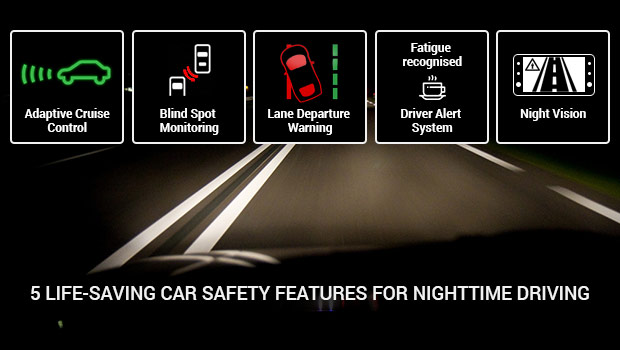Safety of motorists can be at risk while driving at night mainly because of low visibility. Other Factors like driver’s fatigue and emptier roads at night as compared to day time can make a driver less attentive while driving which can have deadly consequences.
Such dangerous situations can be avoided through certain car safety features that are specially designed for nighttime driving. The car safety features, which help while driving at night, reduce the possibility of a human error induced by low visibility, driver fatigue or distracted driving. In order to minimize the risks of nighttime driving, auto manufacturers are now making some of the most important car safety features as standard in their new cars instead of offering them as add-ons.
Let’s find out the five most essential features that can potentially make driving at night safe.
Also read: 7 ways to Drive Safely in Low Visibility Conditions
Adaptive Cruise Control – Say Goodbye to Unintentional Over Speeding at Night
Not regarded entirely as a safety feature for nighttime driving, the Adaptive Cruise Control has a critical role to play in making driving safe at night. With the ability to adjust the speed of the vehicle according to the traffic ahead, the Adaptive Cruise Control feature in modern day cars can potentially reduce the risk of a deadly road collision. This safety feature helps the most at night as it slows down a vehicle automatically if it finds a vehicle reaching the vehicles ahead too quickly. The more advanced type of Adaptive Cruise Control would even stop your vehicle automatically in case of an emergency. This safety feature plays a critical role when it comes to driving on the highway at nighttime which is when most drivers feel drowsy or even doze off due to fatigue and a monotonous environment.
Read our comprehensive blog on Adaptive Cruise Control System for Cars
Blind Spot Monitoring – Remain Aware of the Fast Approaching Vehicles
This is another important car safety feature for driving at night. The blind spot monitoring works in tandem with a radar sensor system that scans the whole area around the vehicle and detects the movements of approaching vehicles. The Blind Spot Monitoring System notifies to the driver if it detects any vehicle in any of the blind spots around the vehicle with the help of either a flash light or through a chime (particular sound, ring or an alarm). The notification suggests the driver to wait before making a lane change thus helps in avoiding a collision.
Also read: Six Most Affordable New Cars with Blind Spot Warning System
Lane Departure Warning – Avoid a Sudden Lane Change
A sudden lane change on a busy road at night can be deadly and in order to avoid such precarious circumstances, the Lane Departure Warning System is essential. This system indicates to the driver if the vehicle is leaving the lane without signalling to the cars behind. It alerts the driver through different warning signals to first indicate to other drivers and then leave the lane. The warning signal could be in form of a vibration in the driver’s seat, a loud alarm or a visual warning on the dashboard. A more advanced Lane Departure Warning System automatically steers the vehicle slightly to keep it in the lane.
Read our comprehensive blog on Understanding the Lane Assist Safety Technology
Driver Alert Systems – Stay Active All the Time while Driving
Inattentive driving caused by fatigue, use of mobile phone or any other distraction has been a leading cause of fatal road accidents at night. The driver alert systems in modern day cars monitor the lack of concentration while driving and alert the driver with the help of a vibration in the seat, visual warning on dashboard or through a warning sound. Major car brands like Nissan, Volvo, Lexus, Ford, Volkswagen and many others have launched their own versions of driver alert systems in their cars. The purpose of all these driving alert systems introduced by different brands in their car is to help the driver maintain focus on the road while driving.
Night Vision – No More Run-over Accidents at Night
The Night Vision safety feature is not a common safety feature in modern cars as it is a very advanced and expensive technology. With many safety features now being offered as a standard, hopefully this safety feature will also be found in the future cars. But it surely does its job and that too in a highly convincing manner by enabling a driver to locate objects beyond the range of the headlights. Usually set as a sensor in the front grille of a car, the night vision detects warm bodies like pedestrians and animals in its range and alerts the driver through a dashboard warning light if the car gets too close to a warm body on the road. The highway run-over accidents involving animals as well as pedestrians can easily become a thing of the past with the use of Night Vision.
Also read: 5 Advanced Vehicle Safety Technologies
Bottom-line
Modern car safety features can help in reducing the risk of a dangerous road accident but being attentive while driving at night is the most important safety protocol. Safety technologies are still evolving and they are getting better by the day, but they are still far from making the vehicle completely autonomous. Even if your car does not have the above-mentioned safety features, you can still avoid a dangerous road accident by being more careful while driving at night. Other than that, knowing your car and understanding all its safety features is also very important to make the appropriate use of these features at the right time.
Looking to buy a new car with better safety features for driving at night? Don’t forget that with us, you can sell any used car in just 30 minutes while all the post-sale paperwork is handled by SellAnyCar.com’s team.



